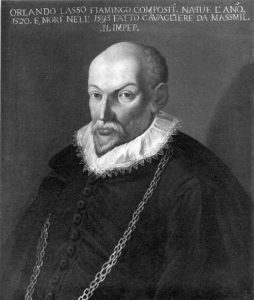Scott Timberg's Blog, page 12
November 24, 2016
“Akhnaten” at Los Angeles Opera
THE Philip Glass opera Akhnaten, the very abstracted story of the Egyptian pharaoh who lived 35 centuries ago, is now at Los Angeles Opera. Glass considers it a trilogy, alongside his epochal Einstein on the Beach and his Gandhi opera, Satyagraha.
Akhnaten the man was a curious guy. Imagine being a fairly important figure — he is credited with basically inventing monotheism through his worship of a sun god, was a pharoah, etc. — and being less well known than your son, Tut. (King Tutankhamun, after all, only reigned for a few years, and died at 18. If he’d been a 21st century American, he would not have been old enough to drink.)
And Miles Davis made an album about Akhnaten’s wife, Nefirtiti.
The Glass opera, which is not put on all that much, thus serves as the introduction to the pharaoh and his plight for a lot of even pretty-educated people.
Because of pre-holiday madness here in the turkey-besotted States, I will have to make this brief, but I quite loved the opera and the LA production.
There was, for what it’s worth, a Black Lives Matter protest outside Chandler Pavilion right before the show.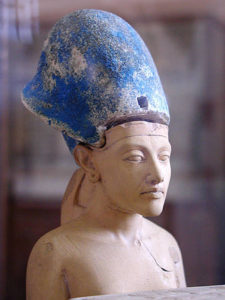
November 16, 2016
The Powerful Influence of Leonard Cohen
IT’S been a very tough year for music lovers, and the last week or so has been especially rough for other reasons. But the legacy left by the late poet/ songwriter is something to be grateful for.
In my latest Salon story, I document the influence of Cohen from the earliest covers of his songs (Judy Collins’ “Suzanne,” Fairport Convention’s “Bird on a Wire”), through his deep shaping influence on younger figures like Lloyd Cole, Nick Cave, and the young indie rock band Car Seat Headrest.
Had I more space and time, I might have mentioned others influenced by Cohen, like the Silver Jews and Bonnie Prince Billy/ Palace Music/ Will Oldham.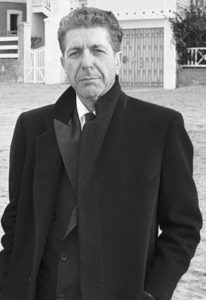
In any case, I and many others will miss Cohen deeply.
November 8, 2016
“Tears of St. Peter” and the Master Chorale
HERE is a piece I had not even heard of: “Lagrime di San Pietro,” a chorale work by the ambiguously Italian composer Orlando di Lasso (who is usually described as Flemish). The Los Angeles Master Chorale put on this Renaissance work, directed by classical wildman Peter Sellars, about a week ago at Disney Hall. Despite my lack of knowledge of most chorale music, I took chance with the concert and was amazed by the weight of of emotion and lonely suffering of the whole thing. Singing lines written by poet Luigi Tansillo, the Master Chorale reached deep into the human soul.
From Mark Swed’s lovely Los Angeles Times review:
Normally, we turn to death-invoking music for its transformative powers. The final great works of Beethoven (the late string quartets), Mozart (the unfinished Requiem) or Mahler (the Ninth Symphony’s probe of dying embers) help us transcend despair. Di Lasso’s “Lagrime,” however, is by a deeply depressed composer in the days before meds, someone who only wants his misery to end. It did in 1594, three weeks after finishing the score.
Even as an agnostic (and one who knows only a few word of Italian) I found the power of this cycle about a dejected man reconciling with Christ almost overwhelming. Swed’s judgement:
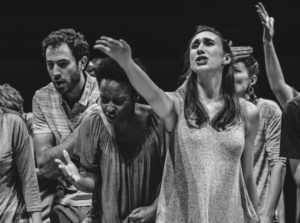
Photo by Tao Ruspoli
“Lagrime” is a major accomplishment for the Master Chorale, which sang and acted brilliantly. It is also a major accomplishment for music history. The company hopes to keep this production alive, touring it, and if the music business chooses to honor the just, that will be a saint’s compensation.
I’ve not seen anything by the Master Chorale in years, but will look forward to what they do next. And I’m eager to see more verse by Luigi Tansillo.
November 7, 2016
Otis Redding at the Whisky — Revisited
YOU can never really have too much Otis Redding. The great R&B singer and songwriter died in a plane crash in 1967, at just 26 years old, and just about everything he recorded (included his radio spot for “Stay in School”) is worth hearing. So it’s good news that a legendary set of concerts — his April 1966 shows at the Whisky a Go Go, which have been available in various forms for years — has been expanded and cleaned up in a new six-CD box set.
Recently, your humble blogger spoke to Lynell George, a veteran Los Angeles journalist who wrote the liner notes to Stax Record’s Live at the Whisky A Go Go: the Complete Recordings. Don’t miss it.
Of all the major figures of soul music — Ray Charles, Sam Cooke, James Brown, Aretha — Otis Redding had the shortest career. But it’s hard to imagine that genre without him. What did he do that no one else could do as deeply or as well?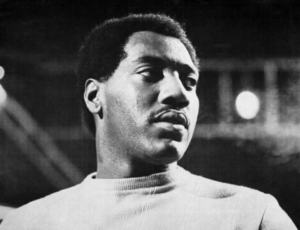
I often think of singers’ voices in terms of shades and or textures — moods I’m reaching for in certain moments. Redding brought a deeply emotional, rawness to settings. It’s palpable. There’s nothing slick. It’s work, work, work. Everything that was interior was in full view in his voice. That’s what was so charged about it. And truly in a certain way because he was so adept of going so deep, expressing longing, pain, regret and ESPECIALLY VULNERABILITY — his voice defined “soul.” He was “Mr. Pitiful” for a reason. As well, you’d hear in those vocal textures the rural South and church etc. mixed in with city, so he was also symbolic of a change that was happening politically and culturally for African Americans as well.
Otis was from Georgia and recorded at Stax in Memphis, but I wonder if Los Angeles and perhaps California had a special meaning for him, because of shows like this one and his breakthrough at Monterey.
He slipped in and out of Los Angeles, but I think what was critical at this moment of his career was stepping from “stardom” to “superstardom” and he knew that California — Los Angeles — in particular, might be the essential ingredient to make that happen. By the time Redding arrives in L.A. for the Whisky gig, he’s being played on stations across the dial, but his hope was that this tour would give him that momentum that would move him into a place where he didn’t have to worry about caring for his family and his legacy.
And too, the anticipation was thick. One of the people I interviewed for the notes, said as he stood outside hoping to get in, he watched Van Morrison step inside. Bob Dylan was also in attendance. It was the “to-see” show.
Some of these Whisky dates have been released before — what’s new about this new box set?
The hope was to finally assemble all three nights in their entirety as they happened. The earlier sets were samplings that pulled together the strongest cuts or a sampling from a few nights. This one is for the completists among us who want to hear the run — end to end from night to night to night.
Was there something special about the Whisky shows that we don’t hear on his studio records and other live dates like his classic Live in Europe record?
The Whisky run is a snapshot of a moment: Not just in music history, but L.A. history. Redding was the first bonafide soul act to play at the Whisky and that brought something new. You can hear it in the crowd in certain sets on certain nights. He’s working very, very hard to bring them along with him. As author Harvey Kubernick pointed out when I spoke to him for my liner notes, Otis had assembled an authentic soul revue. There hadn’t been anything like that on the Strip before — it was a door that opened onto a entirely new sound and way to experience it — so you’ll be able to hear more of that.
November 4, 2016
Lit Crawl L.A./ North Hollywood
THE other night I ventured out to Los Angeles’s North Hollywood neighborhood for the latest installment of Lit Crawl L.A. This annual night out has been going since 2013, but for various reasons I’ve missed it every time, even though NoHo is one of my favorite L.A. ‘hoods. The idea of Lit Crawl is to arrange readings, conversations, rants, and various kinds of performances in an area that is dense enough with restaurants, bars, galleries, and so on to make for a safe and engaging evening in a city that’s notoriously spread-out and car-dependent.
Its organizers call it “Where literature hits the streets.”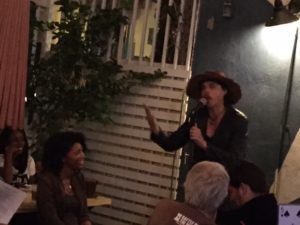
So while I didn’t take in more than a couple hours and a handful of events for Lit Crawl — I’d been out late the night before and had to be up early the next morning — I’d call it a qualified success. That area around the intersection of Lankershim and Magnolia is dense and lively enough that Lit Crawl created a real sense of occasion. Nearly every place I went was packed. (One bar I passed was largely empty and seemed a bit sad– it turned out to be one of the few watering holes in the ‘hood that was not participating.)
On every street there seemed to be people, young and old, walking from reading to reading with enthusiasm, and, often, some kind of fancy eyewear.
Among the places I visited, often briefly, were Pitfire Pizza, Kahuna Tiki (rad), Fat Dog, El Tejano (I still miss Bow and Truss), Eclectic Food and Wine, Republic of Pie, and the very groovy Blastoff Comics. Did I see any deathless literature being recited? Well, probably not, but it can be hard to tell in settings like this.
I certainly saw some engaging poets and prose writers, and at the very least some very funny monologists. I also saw a neighborhood that has doubled down on its art and culture quotient delivering on some of its promise. And I found some cool places I didn’t know: I’d never visited Blastoff, which has a great collection of vintage science-fiction novels, and sheesh! has Magnolia’s stretch of bars gotten hip lately.
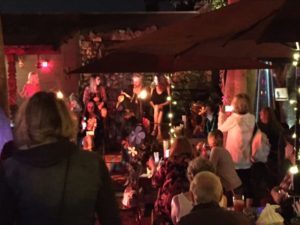 The element I’d like to see in future Lit Crawls — and I don’t know how 2016 compares to years past — is more better-known scribes. Clearly the emphasis was on younger/emerging/avant/small-press writers and recent graduates of writing programs; that’s great. But if a handful of more established figures were involved it would, I hope bring everyone’s game up and attract a larger crowd without altering the indie/ underground/ youthful spirit of the whole thing.
The element I’d like to see in future Lit Crawls — and I don’t know how 2016 compares to years past — is more better-known scribes. Clearly the emphasis was on younger/emerging/avant/small-press writers and recent graduates of writing programs; that’s great. But if a handful of more established figures were involved it would, I hope bring everyone’s game up and attract a larger crowd without altering the indie/ underground/ youthful spirit of the whole thing.
I would have liked to go to the afterparty at one of my favorite local joints, The Federal Bar, but ran out of steam. In any case, next year am looking forward to being better rested and taking in Lit Crawl even more fully.
October 28, 2016
Billy Bragg and Joe Henry Ride the Rails
WHAT happens when you take two of the best exemplars of stage patter in modern music, set them up in historic halls with old acoustic guitars, and let them unleash a set built on classic American train songs? An oddly satisfying, even at times thrilling, grownup show that made the railroad tradition seem like a central part of the American journey.
Bragg is, of course, a veteran British musician whose style comes out of both left-wing punk and Bob Dylan’s social-protest music. Joe Henry is a Southern-reared, LA-dwelling musician who is on the edges of the alt-country movement and also the producer of great albums by Bettye Lavette, Solomon Burke, and the last Billy Bragg record.
The two recently collaborated on an album, “Shine a Light,” covering songs associated with Leadbelly, Hank Williams, Glen Campbell, and Lonnie Donegan, who kicked off the British skiffle fad with his cover of “Rock Island Line” (leading, of course, to a Liverpool quartet the name of which escape me.) The songs were almost all recorded in train stations of trackside while the two trained from Chicago to LA.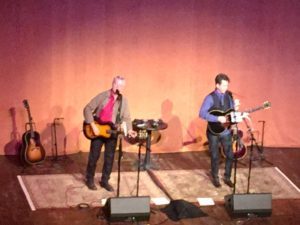
The current tour, which soon moves to the UK and Australia, mines that album quite heavily, in some cases interpreting the songs (Leadbelly’s “In the Pines,” for ex.) in unconventional ways. I’m fond of both Bragg and Henry, and enjoy their love of history and worship of American musical ghosts, so this was a blast for me. The Palace Theatre may be the oldest of the downtown movie palaces turned music venues: Opened in 1911, with a lot of original details and an intimate, quite vertical seating arrangement, it was a perfect place for the show.
If you wanted a pure play-the-hits Billy Bragg show, this is the wrong tour for you. Some of my earliest club-going was as a teenager in the mid-’80s, marveling as Bragg crooned politics and poetry behind an overdriven electric guitar at DC’s “old” 930 Club: Tuesday’s show offered a few songs by solo Bragg, including a riveting “Accident Waiting to Happen.” (Its Kinks-inspired phrase “a dedicated swallower of fascism” got an extra cheer because of a certain presidential candidate.) And I would have loved to hear, say, “Levi Stubbs’ Tears.”
But this was something else, and in its musically austere but emotionally committed way it was profound and luminous. 
October 18, 2016
The bizarre wonder of The Iceland Concert
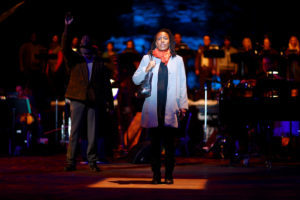
Photo Kevin Campbell
About a week ago I went to see a cryptically named sort-of opera called “The Iceland Concert” at the John Anson Ford Amphitheater. I went mostly because of a vague interest in Scandinavian culture, because I was curious about the renovation of one of my favorite LA theaters, and because I trust the taste of the publicist. It didn’t hurt that the success of groups like Yuval Sharon’s The Industry and Chris Rountree’s wild Up have made Southern California a lively center for new music lately; I hoped this might end up being another part of that unfolding story.
“The Iceland Concert,” by the newish LA group Overtone Industries, tells the tale of a brooding, itinerant Irishman who bumps into a black woman he used to know while walking through an airport; the two were once involved but had drifted apart. After the meeting, they disappear into a folkloric Icelandic setting complete with bizarre woodland creatures. And that’s about all I know or can describe lucidly. I got a bit lost in the storytelling — probably my fault, not the production’s — but the music and setting could hardly have been bettered.
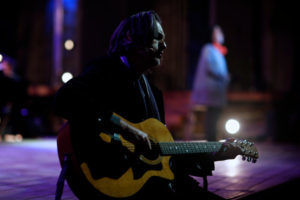
Photo Kevin Campbell
Because the Ford is cut into the hillside near the Cahuenga Pass, and is smartly tiered, with running water and small plazas, it created a rustic, sophisticated, vaguely European environment for the piece.
The renovation of the Ford — which was built in 1920, burned down in 1929, and re-opened in 1931 — doesn’t appear to be complete yet, but it looks good so far, and was a very comfortable place to hand out before the show and at intermissions. (The seating area at least so far, does not appear to have been changed.)
The big surprise was the music. A 10-piece chamber orchestra and 12-voice choir onstage provided the accompaniment to music that was at times in the classical tradition, but also went other places: The woman, Vala, (played by Cesili Williams) sang in a very restrained R&B style. Her old flame, Mundi (played by Irish musician Emmett Tinley) sang and played guitar in a vaguely folky or Celtic mode, with touches of early Van Morrison crossed with Thom Yorke. It should not have all worked well together, but it did.
My only regret is that “The Iceland Concert,” which was written by O-Lan Jones and Tinley, and directed by Ken Roht, only played for one night. I’ll look forward to what this crew, and Overtone Industries in general, cooks up next.
October 3, 2016
August Wilson’s “Ma Rainey” at the Taper
LAST night I caught “Ma Rainey’s Black Bottom” — one of the historically earliest of August Wilson’s cycle of plays about black life in the 20th century — at the Mark Taper Forum. This production, directed by Phylicia Rashad (best known for her role on “The Cosby Show”), has been justly celebrated already, so I will just introduce it and add a few details.
Despite its title, and an extroverted and soulful performance by Lillias White as the Queen of the Blues, the play is not primarily about Ma Rainey but the backup musicians who assembled one afternoon in 1927 at a Chicago recording studio to accompany her. It’s their chemistry with each other, their views of musical artistry, their relationship to the white mainstream, that gives the play most of its real drama.
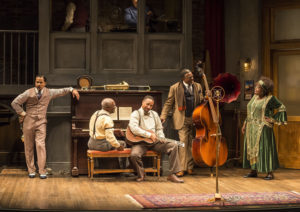
L-R: Jason Dirden, Glynn Turman, Damon Gupton, Keith David and Lillias White in August Wilsons “Ma Raineys Black Bottom,” directed by Phylicia Rashad, playing through October 16, 2016, at Center Theatre Group/Mark Taper Forum at the Los Angeles Music Center. For tickets and information, please visit CenterTheatreGroup.org or call (213) 628-2772. Contact: CTGMedia@ctgla.org/ (213) 972-7376. Photo by Craig Schwartz.
It’s hard to imagine the acting in the play being any better. The four actors were convincing as ’20s blues musicians, and each had distinctive mannerisms and a lived-in worldview. The most central of the four, probably, was Jason Dirden, who played Levee, a trumpeter who saw himself as an artist and songwriter and not a mere hired hand.
Levee’s point of view echoes something Rainey says: “If you’re colored and can make them some money, then you alright with them. Otherwise, you just a dog in the alley.”
Remarkably, all four actors were decent musicians, and their brief bits of playing made up some of the highlights of the play. That’s partly because of the beauty of ’20s jazz and Rainey’s music in specific. It’s also because even most serious music fans have only heard the original music on very scratchy old recordings. (And because the best known music in this style was played by Louis Armstrong’s Hot Fives and Hot Sevens, the four piece version of songs like “Hear Me Talkin’ To Ya” had a lighter, more open quality.) Those old recordings are wonderful, but seeing these songs live was a real pleasure, and helped show why the play’s principles had devoted themselves to what can be such a frustrating life.
Much of the early parts of the play involve comic banter and one-upmanship by the band members, and a lot of it was hilarious. Despite my deep respect for Wilson — and I understand this is an attempt to define the characters and to built a tone that will pivot very seriously — there was a few minutes too much in both acts. There was also one dramatic high point involving Levee played a hair too high for me.
But “Ma Rainey” was mostly a dramatic triumph. I won’t give any more of the plot away, but I’ll just say that Wilson’s goal — to show the complexity of black life, to say something about the paradox of artistry, and to illuminate individual souls — is quite well realized by the grim conclusion.
I’d not been to the Taper in more than a year, and was struck by how intimate and effective a space it is.
Remarkably, while I was enjoying the play (with a musician friend with whom I sometimes play jazz guitar), the 83-year-old man who founded the Taper and played perhaps the most important role in establishing theater in Los Angeles — Gordon Davidson — collapsed after dinner, and died. More on Davidson soon, but he was a titan.
Happy 80th to Steve Reich
A FEW years back I spent an hour or so with Steve Reich before a concert of his work. Here is the story I wrote about the pioneering minimalist, who marks his 80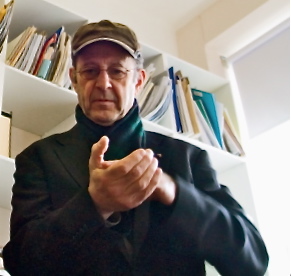 th birthday today.
th birthday today.
I was struck by how down to earth Reich was, also how deep his love of Bartok seemed to be.
Reich’s “Different Trains” and “Music for 18 Musicians” are two of my all-time favorite pieces. Seeing the latter at Walt Disney Concert Hall was one of the most startling shows I’ve ever ever seen — all those singers.
September 19, 2016
Kraftwerk at the Hollywood Bowl
KRAUTROCK has rarely been my cup of ale; the only German rock band I’ve ever loved is Neu!, and it took years of listening to Stereolab to adjust my metabolism to the repetitive, minimal, technophile grooves. But I’ve heard so many good things about the shows Kraftwerk — who all but invented the genre, and scored its first big U.S. hit with “Autobahn” — performed at Disney Hall a few years ago, that their Bowl show was hard to pass up.
It’s strange to see a concert where almost none of the instruments are played live: Most of what we saw last night was prerecorded “robot music,” and the band emphasizes a kind of ice-cold mechanical delivery that fits cleanly with a stereotype of hyper-rational postwar Germans. But the show, dominated as it was by 3-D projections of abstract patterns, silent film heroines, decades-old French bicycle races, and interstellar flights, was a thing of wonder.
At times the show was like one of those shows where a band plays behind a movie, like Philip Glass’s “Beauty and the Beast” or the Bill Frisell performances behind Buster Keaton movies.
There were of course various floating themes abut the role of the machine in modern Western life, and the meaning of being human in an age where humanism seems to be on the wane.
Can I make the slightly less profound comment that the Bowl may be the most delightful place to see music of any kind? I wish more of the season was left.
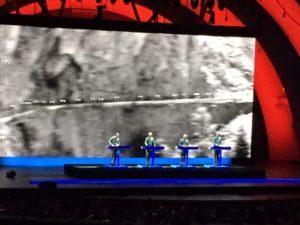 (Of course, Neu! was formed by two exiles from Kraftwerk, frustrated by their old band.)
(Of course, Neu! was formed by two exiles from Kraftwerk, frustrated by their old band.)
Scott Timberg's Blog
- Scott Timberg's profile
- 7 followers


